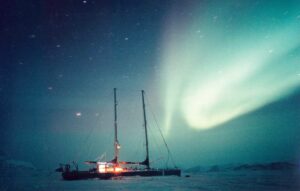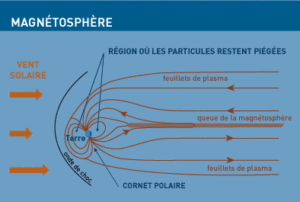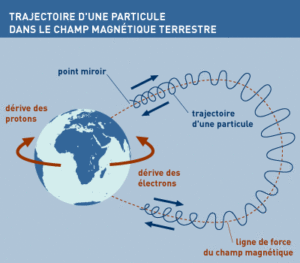
CONTENTS
OCEAN AND MARINE LIFE
- THE ARCTIC OCEAN AND THE OCEAN CURRENTS
- GENESIS OF THE ARCTIC OCEAN
- ARCTIC PLANKTON
- MARINE BIODIVERSITY AND FOOD WEB
- WHALES AND OTHER CETACEANS
- SEALS AND WALRUSES
TERRESTRIAL LIFE
- POLAR FLORA
- POLAR FAUNA
- THE POLAR BEAR
- ARCTIC BIRDS
- SPECIES EVOLUTION AND CLIMATE
HISTORY AND GEOGRAPHY
- GEOGRAPHY OF THE ARCTIC REGIONS
- GEOGRAPHIC NORTH POLE, MAGNETIC NORTH POLE
- WHO OWNS THE ARCTIC?
- THE EXPLORERS OF THE FAR NORTH
- THE INUIT
- OTHER PEOPLES OF THE FAR NORTH
- THE ARCTIC TODAY
A BLANKET OF GAS AROUND THE EARTH
The air we breathe forms the Earth’s gaseous envelope, known as the atmosphere. Nearly half of this fluid mass does not exceed 5,000 meters in altitude. This is very little, compared to the Earth’s radius of 6,400 kilometers! And yet, it is the atmosphere that creates the favorable conditions for life to flourish on our planet’s surface.

Polar aurora above Antarctica, during wintering in Spitsbergen. © F. Latreille/Septième continent.

4 SUPERIMPOSED LAYERS
The lowest layer in which we live, the troposphere, is the densest zone, that of clouds and climate; its ceiling (–60°C) is located on average at an altitude of 12 km. Above it, three more levels are distinguished (stratosphere, mesosphere, and thermosphere) based on temperature, before entering interplanetary space, beyond 1,500 km.
WHAT IS IN THE ATMOSPHERE?
Nitrogen, oxygen, argon, and other rare gases are present in very stable proportions in the atmosphere. Only the concentrations of gases linked to human activity (carbon dioxide, ozone, etc.), which are very low, are variable. This air represents 98% of the atmosphere’s weight; the rest consists of water and fine particles, called aerosols (dust, pollen, salt crystals…).
Anticyclones and depressions: our atmosphere is far from calm! The Sun and the Earth’s rotation are responsible for this commotion. The Sun heats the air unevenly across the globe’s surface, creating a system of high and low pressures around which, under the effect of the planet’s rotation, winds swirl.
VERY HIGH, ABOVE THE CLOUDS…
As one ascends in altitude, the temperature first decreases, to about –50°C above the poles and –85°C above the equator (where the air at altitude is therefore colder than at the poles!). This ‘ceiling,’ called the tropopause, is 3 times lower at the poles (6 km) than at the equator (17 km) due to the Earth’s rotation. It defines the lower layer of the atmosphere, the troposphere: the one where we live. Concentrating virtually all water vapor (99.99%), this lower atmosphere is the site of precipitation and climates; it is also where airplanes fly.
Above it, the stratosphere begins: the temperature there increases again up to 0°C at around 45 km altitude, then decreases to about -90°C at 90 km. This forms a new layer, the mesosphere. Then, the temperature rises again to over 1000°C in the thermosphere.
STRANGE INTERPLANETARY TRAVELERS
All around our planet, even beyond the atmosphere, infinite space is not empty. It is constantly traversed by all sorts of particles expelled by stars, and especially by the Sun. Most of these particles are identical to those that make up the atoms of matter (electrons, neutrons, protons); others, less common, are called alpha particles, mesons, neutrinos, etc. Permanently, the Earth’s environment is thus bombarded by these various particles.
Space is also traversed in all directions by visible light and by a whole range of radiations from the same family (electromagnetic waves) but which are invisible to us: gamma rays, X-rays, ultraviolet, infrared, microwaves, radio waves, etc.
The energy of these particles and waves depends on their origin.
LIKE A SCARF IN THE WIND: THE MAGNETOSPHERE
In space, the Earth behaves like a giant magnet, and its field forms a kind of immense invisible protective cocoon around the globe: the magnetosphere. This magnetosphere is not at all round, but stretches into space like the tail of a comet.
Indeed, the Sun constantly ‘blows’ a wind of particles (solar wind) that strikes the magnetosphere head-on: it compresses it forward (day side) and stretches it on the opposite side (night side) for millions of kilometers, far beyond the Moon’s orbit, much like a scarf.

HUMANS UNDER COSMIC INFLUENCE
By channeling them around the world, the magnetosphere protects us from interplanetary particles… while also causing some astonishing phenomena. For example, these bombardments sometimes disrupt radio communications (magnetic storms); they were also responsible for the power outage that plunged New York into darkness in 1972 (due to the generation of strong circumterrestrial electric currents) and the premature fall of the Skylab satellite in 1979 (braking due to a burst of solar wind)! Finally, these cosmic particles, comparable to radioactive radiation, can also have consequences for human health if exposed to them.
COSMIC PARTICLES GUIDED BY THE EARTH’S MAGNET
At the poles, where the magnetic field ’emerges’ from the globe, are the ‘polar cusps,’ a type of magnetic funnel open to space. When ‘charged’ cosmic particles enter the magnetosphere, they follow the Earth’s magnetic field lines like actual rails. Generally, they cannot penetrate deeply into the cusps where these rails narrow: they then ‘bounce’ indefinitely from one pole to the other, while drifting around the world.
THE POLAR AURORAS: A BIT OF COSMOS ENTERING THROUGH EARTH’S WINDOWS
The most energetic particles that descend too low into the polar magnetic funnels ‘excite’ the atoms and molecules in the air… which then emit light. For the people of the Far North, these are the magnificent ‘aurora borealis’ that illuminate the night skies. Auroras that, therefore, have nothing to do with sunrise! Their colors and shapes depend on the excited atoms and altitude: oxygen emits a yellow-green, nitrogen purple and pink, hydrogen red…
Such are the secrets of the curtains of light that sometimes float in our sky and directly inform us about the Sun’s whims and upheavals.
THE PHYSICISTS’ CORNER
The energy of a moving matter particle depends on its mass and its speed (kinetic energy). Physicists measure particle energy in electronvolts (eV).
An electronvolt is the energy acquired by an electron accelerated by a potential difference of one volt. It is very small… but very convenient in the world of particles! Imagine: one volt is a potential difference 220 times weaker than that delivered by power outlets; and it takes a flow of 600 billion billion electrons per second to create a current of 1 ampere, which is barely the consumption of a chandelier in a living room! (1 eV = 1.6 x 10^-19 J!).
DID YOU KNOW?
Overall, the atmosphere weighs nearly 5 million billion tons; a mass, however, 3000 times smaller than the mass of all the world’s water alone!
Although very rare, polar auroras can occur at our latitudes. It is said that in the year 37, an intense glowing aurora led the Romans to believe that Ostia was on fire.
Quite different from cosmic particles, dust (micrometeorites) also travels through the solar system. Some researchers are looking for these interplanetary dust particles, particularly those that have fallen into the ice of Greenland and Antarctica. They estimate that approximately 50 to 100 tons of micrometeorites (the majority of which have a diameter of about 50 to 500 micrometers) accumulate on the Earth’s surface each day. This is nearly 2000 times more than the weight of actual meteorites that reach us (approximately 0.03 tons per day).
FURTHER READING…
BIBLIOGRAPHY
- Educational Resource: The Arctic and the Boreal Environment (P. Avérous CNDP, 1995)
- Erebus Expedition (J.-L. Etienne/P. Avérous- Arthaud-1994)
- Educational Resource: “EREBUS”: The Polar Environment 2 (P. Avérous-Autrement dit, CNDP-1994)
- Will it Rain, Won’t it Rain – Weather at the Whim of Time (R. Chaboud – Découvertes Gallimard-1994)
- Encyclopedia Universalis
- Earth… Our Planet (P. Avérous-Nathan-1990)
- Atmosphere, Atmosphere (Science & Vie, Special Issue No. 174-1991)
- What Climate for Tomorrow? (S. Huet, Calmann-Levy, 2000)
- The Uncertainty of Climates (R. Kandel, Hachette, 1998)
- Earth’s Climate (R. Sadourny, DOMINOS, Flammarion, 1994)
CONTENTS
ARCTIC ICE
- SEA ICE: MARINE ICE
- SATELLITES OBSERVE SEA ICE
- ICEBERGS: FROZEN FRESH WATER
- THE ARCTIC ICE: CLIMATE ARCHIVES
- ICE AGES AND LANDSCAPES
OCEAN AND MARINE LIFE
- THE ARCTIC OCEAN AND THE OCEAN CURRENTS
- GENESIS OF THE ARCTIC OCEAN
- ARCTIC PLANKTON
- MARINE BIODIVERSITY AND FOOD WEB
- WHALES AND OTHER CETACEANS
- SEALS AND WALRUSES
TERRESTRIAL LIFE
- POLAR FLORA
- POLAR FAUNA
- THE POLAR BEAR
- ARCTIC BIRDS
- SPECIES EVOLUTION AND CLIMATE
HISTORY AND GEOGRAPHY
- GEOGRAPHY OF THE ARCTIC REGIONS
- GEOGRAPHIC NORTH POLE, MAGNETIC NORTH POLE
- WHO OWNS THE ARCTIC?
- THE EXPLORERS OF THE FAR NORTH
- THE INUIT
- OTHER PEOPLES OF THE FAR NORTH
- THE ARCTIC TODAY
A BLANKET OF GAS AROUND THE EARTH
The air we breathe forms the Earth’s gaseous envelope, known as the atmosphere. Nearly half of this fluid mass does not exceed 5,000 meters in altitude. This is very little, compared to the Earth’s radius of 6,400 kilometers! And yet, it is the atmosphere that creates the favorable conditions for life to flourish on our planet’s surface.

Polar aurora above Antarctica, during wintering in Spitsbergen. © F. Latreille/Septième continent.

4 SUPERIMPOSED LAYERS
The lowest layer in which we live, the troposphere, is the densest zone, that of clouds and climate; its ceiling (–60°C) is located on average at an altitude of 12 km. Above it, three more levels are distinguished (stratosphere, mesosphere, and thermosphere) based on temperature, before entering interplanetary space, beyond 1,500 km.
WHAT IS IN THE ATMOSPHERE?
Nitrogen, oxygen, argon, and other rare gases are present in very stable proportions in the atmosphere. Only the concentrations of gases linked to human activity (carbon dioxide, ozone, etc.), which are very low, are variable. This air represents 98% of the atmosphere’s weight; the rest consists of water and fine particles, called aerosols (dust, pollen, salt crystals…).
Anticyclones and depressions: our atmosphere is far from calm! The Sun and the Earth’s rotation are responsible for this commotion. The Sun heats the air unevenly across the globe’s surface, creating a system of high and low pressures around which, under the effect of the planet’s rotation, winds swirl.
VERY HIGH, ABOVE THE CLOUDS…
As one ascends in altitude, the temperature first decreases, to about –50°C above the poles and –85°C above the equator (where the air at altitude is therefore colder than at the poles!). This ‘ceiling,’ called the tropopause, is 3 times lower at the poles (6 km) than at the equator (17 km) due to the Earth’s rotation. It defines the lower layer of the atmosphere, the troposphere: the one where we live. Concentrating virtually all water vapor (99.99%), this lower atmosphere is the site of precipitation and climates; it is also where airplanes fly.
Above it, the stratosphere begins: the temperature there increases again up to 0°C at around 45 km altitude, then decreases to about -90°C at 90 km. This forms a new layer, the mesosphere. Then, the temperature rises again to over 1000°C in the thermosphere.
STRANGE INTERPLANETARY TRAVELERS
All around our planet, even beyond the atmosphere, infinite space is not empty. It is constantly traversed by all sorts of particles expelled by stars, and especially by the Sun. Most of these particles are identical to those that make up the atoms of matter (electrons, neutrons, protons); others, less common, are called alpha particles, mesons, neutrinos, etc. Permanently, the Earth’s environment is thus bombarded by these various particles.
Space is also traversed in all directions by visible light and by a whole range of radiations from the same family (electromagnetic waves) but which are invisible to us: gamma rays, X-rays, ultraviolet, infrared, microwaves, radio waves, etc.
The energy of these particles and waves depends on their origin.
LIKE A SCARF IN THE WIND: THE MAGNETOSPHERE
In space, the Earth behaves like a giant magnet, and its field forms a kind of immense invisible protective cocoon around the globe: the magnetosphere. This magnetosphere is not at all round, but stretches into space like the tail of a comet.
Indeed, the Sun constantly ‘blows’ a wind of particles (solar wind) that strikes the magnetosphere head-on: it compresses it forward (day side) and stretches it on the opposite side (night side) for millions of kilometers, far beyond the Moon’s orbit, much like a scarf.

HUMANS UNDER COSMIC INFLUENCE
By channeling them around the world, the magnetosphere protects us from interplanetary particles… while also causing some astonishing phenomena. For example, these bombardments sometimes disrupt radio communications (magnetic storms); they were also responsible for the power outage that plunged New York into darkness in 1972 (due to the generation of strong circumterrestrial electric currents) and the premature fall of the Skylab satellite in 1979 (braking due to a burst of solar wind)! Finally, these cosmic particles, comparable to radioactive radiation, can also have consequences for human health if exposed to them.
COSMIC PARTICLES GUIDED BY THE EARTH’S MAGNET
At the poles, where the magnetic field ’emerges’ from the globe, are the ‘polar cusps,’ a type of magnetic funnel open to space. When ‘charged’ cosmic particles enter the magnetosphere, they follow the Earth’s magnetic field lines like actual rails. Generally, they cannot penetrate deeply into the cusps where these rails narrow: they then ‘bounce’ indefinitely from one pole to the other, while drifting around the world.
THE POLAR AURORAS: A BIT OF COSMOS ENTERING THROUGH EARTH’S WINDOWS
The most energetic particles that descend too low into the polar magnetic funnels ‘excite’ the atoms and molecules in the air… which then emit light. For the people of the Far North, these are the magnificent ‘aurora borealis’ that illuminate the night skies. Auroras that, therefore, have nothing to do with sunrise! Their colors and shapes depend on the excited atoms and altitude: oxygen emits a yellow-green, nitrogen purple and pink, hydrogen red…
Such are the secrets of the curtains of light that sometimes float in our sky and directly inform us about the Sun’s whims and upheavals.
THE PHYSICISTS’ CORNER
The energy of a moving matter particle depends on its mass and its speed (kinetic energy). Physicists measure particle energy in electronvolts (eV).
An electronvolt is the energy acquired by an electron accelerated by a potential difference of one volt. It is very small… but very convenient in the world of particles! Imagine: one volt is a potential difference 220 times weaker than that delivered by power outlets; and it takes a flow of 600 billion billion electrons per second to create a current of 1 ampere, which is barely the consumption of a chandelier in a living room! (1 eV = 1.6 x 10^-19 J!).
DID YOU KNOW?
Overall, the atmosphere weighs nearly 5 million billion tons; a mass, however, 3000 times smaller than the mass of all the world’s water alone!
Although very rare, polar auroras can occur at our latitudes. It is said that in the year 37, an intense glowing aurora led the Romans to believe that Ostia was on fire.
Quite different from cosmic particles, dust (micrometeorites) also travels through the solar system. Some researchers are looking for these interplanetary dust particles, particularly those that have fallen into the ice of Greenland and Antarctica. They estimate that approximately 50 to 100 tons of micrometeorites (the majority of which have a diameter of about 50 to 500 micrometers) accumulate on the Earth’s surface each day. This is nearly 2000 times more than the weight of actual meteorites that reach us (approximately 0.03 tons per day).
FURTHER READING…
BIBLIOGRAPHY
- Educational Resource: The Arctic and the Boreal Environment (P. Avérous CNDP, 1995)
- Erebus Expedition (J.-L. Etienne/P. Avérous- Arthaud-1994)
- Educational Resource: “EREBUS”: The Polar Environment 2 (P. Avérous-Autrement dit, CNDP-1994)
- Will it Rain, Won’t it Rain – Weather at the Whim of Time (R. Chaboud – Découvertes Gallimard-1994)
- Encyclopedia Universalis
- Earth… Our Planet (P. Avérous-Nathan-1990)
- Atmosphere, Atmosphere (Science & Vie, Special Issue No. 174-1991)
- What Climate for Tomorrow? (S. Huet, Calmann-Levy, 2000)
- The Uncertainty of Climates (R. Kandel, Hachette, 1998)
- Earth’s Climate (R. Sadourny, DOMINOS, Flammarion, 1994)


